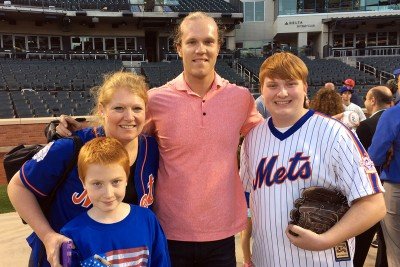Terri’s Story
Terri knew something was wrong with her health, but doctors couldn’t pinpoint the cause. When she came to Memorial Sloan Kettering, she received an accurate diagnosis — and had a surgery that changed her life.

Terri with her sons Sean (left), Dan (far right), and New York Mets pitcher Noah Syndergaard. Terri was suffering from Cushing's disease when the photo was taken.
- Doctors had differing opinions as to why Terri Leno was feeling unwell.
- A chance meeting with a friend led her to Eliza Geer, a neuroendocrinologist at Memorial Sloan Kettering.
- Dr. Geer discovered that Terri had Cushing’s disease, and the two agreed on a surgical treatment plan.
- Terri had surgery in March 2017 and is on the road to recovery.
The vague symptoms Terri Leno had been experiencing in 2014 led to a laundry list of diagnoses from different doctors — but no clear solution.
Terri, a pediatric nurse and married mother of three from West Hempstead, New York, had put on weight and wasn’t feeling like herself. Every doctor she saw had a different root cause in mind: mononucleosis, fibromyalgia, multiple sclerosis, sleep apnea. The list went on and on.
“I went from one facility to another, and the comparisons didn’t add up,” the now 44-year-old recalls.
She thought she was getting closer to an answer when a doctor diagnosed her with hypoglycemia and put her on a strict diet.
“Within several weeks, I dropped 15 of the 30 pounds I had gained, and I was feeling pretty good,” she says. “But I guess it was a Band-Aid on a hemorrhaging wound.”
When the weight crept back on, Terri decided to see an endocrinologist, who did some blood work and saw something that raised his eyebrows. Years prior, Terri had been diagnosed with a pituitary adenoma, a benign tumor in the pituitary gland underneath the brain. But it hadn’t been growing, so doctors kept discounting its importance — even though that didn’t seem right to Terri.
Endocrinologists, Tests, and Overwhelming Stress
Terri was disappointed by the endocrinologist’s approach to care.
“He started yelling at me for not coming in sooner based on the adenoma,” she says. “He made me feel so stupid.”
Terri went back to her primary care doctor for more lab work. The results showed that her cortisol — a hormone that’s released in response to stress — and urine were abnormal, so her doctor sent her to a different endocrinologist. Terri had begun to suspect Cushing’s syndrome, a condition that develops when the cortisol level is elevated for a long time. When the rise in cortisol is due to a pituitary tumor, it is referred to as Cushing’s disease.
But once again, Terri was met with resistance.
“I didn’t leave her office once without crying because I was given advice such as, ‘Go to Weight Watchers,’” Terri says. “I was beside myself. I could tell I wasn’t the patient for her.”
That doctor referred Terri to yet another endocrinologist, who recommended genetic counseling to look for abnormalities at a more microscopic level. The genetic counselor whom Terri saw found no genetic problems and agreed that her case looked like Cushing’s. Terri went back to her most recent endocrinologist and advocated for herself.
“At this point, I knew in my heart it was Cushing’s disease,” she says. “I pressed really hard and said, ‘I cannot do this anymore, keep waiting for tests and then be told everything looks good when I know there’s something wrong with me.’”
But thankfully, she would soon have relief.
Finally, an Answer: Cushing’s Disease
In early 2017, Terri was telling a friend about her health woes. That friend knew a woman, Lauren, who had been diagnosed with Cushing’s disease. The two women spoke, and Terri instantly found a connection.
“She was saying the same exact things that I had been thinking, feeling, and saying for three years,” Terri says. She knew she had to follow in Lauren’s footsteps.
Lauren had been seeing Eliza Geer, a neuroendocrinologist at Memorial Sloan Kettering and Director of MSK’s Multidisciplinary Pituitary and Skull Base Tumor Center. Terri called to make an appointment with Dr. Geer, providing her office with 75 pages of medical records.
At her first appointment with Dr. Geer, Terri knew she had come to the right place.
“It was so validating because she listened to me,” Terri says. “Dr. Geer took her time and looked at all of my results and told me, ‘I don’t want you to suffer any longer.’”
A Plan Comes Together

Terri before Cushing’s disease
Even though most pituitary adenomas are not considered cancerous, Dr. Geer was well prepared to take on Terri’s case.
“I get a lot of referrals from other endocrinologists because they don’t have the familiarity that we do with pituitary adenomas,” she says. “It’s really essential that patients come to a place where it’s very routine for us. Even though we generally don’t describe this as a cancer, it’s still a tumor, and patients need to achieve tumor control.”
Dr. Geer suspected Cushing’s disease when she first met with Terri but wanted to be thorough in her approach.
“Making a diagnosis of Cushing’s is tricky because some of the symptoms — weight gain, mood changes, insomnia — are very common,” Dr. Geer says. “And with Cushing’s, you can’t really rely on one test to make the diagnosis. You have to look at the results from a few tests in the context of the symptoms and put the whole picture together.”
That was a job for MSK’s Multidisciplinary Pituitary and Skull Base Tumor Center. The center brings together neurosurgeons, endocrinologists, head and neck specialists, and other experts. All of the doctors work together to coordinate and deliver the best possible care for each patient.
“I wanted to cry knowing I could have all of my testing done under one roof and that I didn’t have to call multiple doctors,” Terri recalls.
Convenience for the patient is not the only benefit to a team approach to care, however, says Dr. Geer.
“Pituitary patients really need this kind of care,” she says. “There’s the endocrine aspect, the surgical aspect, and some patients need other treatments, such as radiation. It’s critical for us to communicate and work as a team.”
Ultimately, Dr. Geer ordered one more test that gave her more insight into Terri’s cortisol level. When the results came back, Dr. Geer was confident that a surgery to take out the adenoma would dramatically help.
“Surgery is the first-line treatment for Cushing’s disease,” she says. “If you can find that small adenoma and remove it, you can achieve remission.”
In March 2017, Terri underwent surgery at Memorial Hospital. Neurosurgeon Viviane Tabar and head and neck surgeon Marc Cohen were able to remove the tumor through Terri’s nose in a minimally invasive procedure. Because it was an endoscopic surgery, Terri didn’t experience any bruising or swelling on her face.
The results were just as Dr. Geer expected: A pathology report and Terri’s postsurgical cortisol level confirmed that she was finally in remission from Cushing’s disease.
“Those values are predictive of a long-term remission, so it was an excellent outcome,” Dr. Geer says.
Terri was thrilled to finally have the support she so desperately needed.
“Until I met Dr. Geer, I felt very much alone,” she says. “Finding Dr. Geer and MSK was a godsend.”
Looking to the Future
Now, Terri visits Dr. Geer approximately every two months to make sure her hormone levels continue to stabilize postsurgery. Dr. Geer says that hormonal fluctuations can make for a challenging first year after achieving Cushing’s remission, but Terri feels well on her way to making a full recovery.
“I’m definitely leaps and bounds better than I was even two months ago,” she says. “Every day I feel a little bit more of myself poking out. If I could help just one person not go through the three years of absolute agony I went through, I’ll feel like I helped.”




